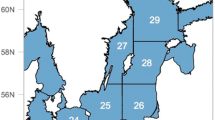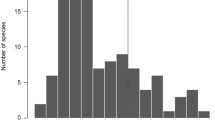Abstract
Gordon (1953,J. Fish. Res. Bd Can.10, 442–457) used economic theory to predict how catch rates, price and fishing costs should balance in a multi-area, open-access fishery. We use the data from the Tasmanian rock lobster fishery to test this theory. We find that, as prediced by theory, areas with higher monetary and non-monetary costs have consistently higher catch rates than areas with lower costs. We show that this theory also predicts that an increase in price would result in an overall increase in catch rate, and suggest that in fisheries with spatial variation in costs, catch rates may be determined as much by economic factors as biological ones.
Similar content being viewed by others
Literature
Abrahams, M. V. and M. C. Healey. 1990. Variation in the competitive abilities of fishermen and its influence on the spatial distribution of the British Columbia salmon troll fleet.Can. J. Fish. Aquat. Sci. 47, 1116–1121.
Anderson, L. G. 1982. The economics of multi-purpose fleet behavior. InEssays in the Economics of Renewable Resources, L. J. Mirman and D. F. Spulber (Eds), pp. 203–226. Amsterdam: North Holland.
Booth, J. D., R. J. Street and P. J. Smith. 1990. Systematic status of the rock lobsterJasus edwardsii from New Zealand andJ. novaehollandiae from Australia.N.Z. J. Mar. Freshwat. Res. 24, 239–249.
Caddy, J. F. 1975. Spatial model for an exploited shellfish population, and its application to the Georges Bank scallop fishery.J. Fish. Res. Bd Can. 32, 1305–1328.
Charnov, E. L. 1976. Optimal foraging: the marginal value theorem.Theor. Popul. Biol. 9, 129–136.
Clark, C. W. 1982. Concentration profiles and the production and management of marine fisheries. InEconomic Theory of Natural Resoruces, W. Eichhorn (Ed.), pp. 97–112. Warzburg-Wein: Physica-Verlag.
Clark, C. W. 1985.Bioeconomic Modelling and Fisheries Management. New York: John Wiley and Sons, 291 pp.
Fretwell, S. D. 1972.Populations in a Seasonal Environment. Princeton, New Jersey: Princeton University Press, 217 pp.
Fretwell, S. D. and H. L. Lucas. 1970. On territorial behaviour and other factors influencing habitat distribution in birds.Acta Biotheor. 19, 16–36.
Gordon, H. S. 1953. An economic approach to the optimum utilization of fishery reources.J. Fish. Res. Bd Can. 10, 442–457.
Hilborn, R. 1985. Fleet dynamics and individual variation: why some people catch more fish than others.Can. J. Fish. Aquat. Sci. 42, 2–13.
Hilborn, R. and M. Ledbetter. 1979. Analysis of the British Columbia salmon purse seine fleet: dynamics of movement.J. Fish. Res. Bd Can. 36, 384–391.
Hilborn, R. and C. J. Walters. 1987. A general model for simulation of stock and fleet dynamics in spatially heterogeneous fisheries.Can. J. Fish. Aquat. Sci. 44, 1366–1369.
Hilborn, R. and C. J. Walters. 1991.Fisheries Stock Assessment and Management Choice, Dynamics and Uncertainty. New York: Routledge, Chapman and Hall.
Huppert, D. D. 1979. Implications of multipurpose fleets and mixed stocks for control policies.J. Fish. Res. Bd Can. 36, 845–854.
McKelvey, r. 1983. The fishery in a fluctuating environment: coexistence of specialists and generalists fishing vessels in a multipurpose fleet.J. Environ. Econ. Mgmt 10, 287–309.
Millington, P. A. 1984. Movement patterns in the British Columbia salmon gill net fleet. M.Sc. thesis, Department of Zoology, University of British Columbia.
Prince, J. D. 1989. The fisheries biology of the Tasmanian stocks of Haliotis rubra. Ph.D. thesis. Department of Zoology, University of Tasmania.
Winstanley, R. H. 1973. Rock lobster fishing in Tasmania.Tas. Fish. Res. 7, 1–23.
Author information
Authors and Affiliations
Rights and permissions
About this article
Cite this article
Hilborn, R., Kennedy, R.B. Spatial pattern in catch rates: A test of economic theory. Bltn Mathcal Biology 54, 263–273 (1992). https://doi.org/10.1007/BF02464833
Received:
Revised:
Issue Date:
DOI: https://doi.org/10.1007/BF02464833




